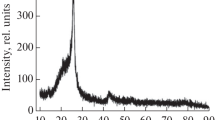Abstract
Measurements of contact angle for water, glycerol, formamide and diiodomethane on surfaces of zirconia ceramic stabilized with 4% magnesia, zirconia ceramic stabilized with 3% yttria, zirconia ceramic stabilized with 5% yttria, tetragonal-Y-zirconia ceramic, cubic-Y-zirconia ceramic, zirconium (IV) oxide, aluminum oxide, magnesium oxide and yttrium oxide were conducted. Using the values of contact angle, the total surface free energy of these solids, and its components resulting from different kinds of intermolecular interactions were calculated. It was found that the Lifshitz-van der Waals component of the surface free energy of zirconia ceramics only slightly depends on the amount and kind of metal oxides present in the ceramics. The acid-base component of all the studied solids is lower than 13 mJ/m2, showing a small dependence on the kind of metal oxide. For all samples studied the electron-donor parameter of the acid-base components of the surface free energy is many times higher that electron-acceptor one. It was stated that the acid-base component probably depends on the density of OH groups on the surface of the solids studied.
Similar content being viewed by others
References
A. W. Adamson, “Physical Chemistry of Surface,” 5th ed. (Wiley-Interscience, New York, 1991).
M. Naka and Y. Okamoto, Trans. JWRI 13(1984) 29.
M. Naka, M. Ueki and Y. Okamoto, ibid. 14(1985) 193.
F. M. Fowkes, Ind. Eng. Chem. 56(1964) 40.
D. K. Owens and R. C. Wendt, J. Appl. Polymer Sci. 13(1969) 1741.
D. H. Kaelble and C. Uy, J. Adhesion 2(1970) 50.
S. Wu, in “Polymer Blends,” Vol. 1, edited by D. R. Paul and S. Newman (Academic Press, New York, 1978) p. 243.
K. L. Mittal, in “Adhesion Science and Technolog,” Vol. 9A, NCZUK and T. BIALOPIOTROWICZ, J. Colloid Interface Sci. 127 (1989) 189.
C. J. van Oss, R. J. Good and M. K. Chaudhury, J. Chromatogr. 391(1987) 53.
C. J. van Oss,R. J. Good and H. Busscher, J. Dispersion Sci. Technol. 11(1990) 75.
C. J. van Oss, M. K. Chaudhury and R. J. Good, J. Chem. Rev. 88(1988) 927.
B. Ja´nczuk and T. Bialopiotrowicz, Clay Mineral 36(1988) 244.
B. Ja´nczuk, J. M. Bruque, M. L. Gonz´alezmart´in and J. Morenodelpozo, J. Colloid Interface Sci. 161(1993) 209.
B. Ja´nczuk, W. W´ojcik and A. Zdziennicka, ibid. 157(1993) 384.
B. Ja´nczuk, E. Chibowski, J. M. Bruque, M. L. Kerkeb and F. Gonz´alez-Caballero, ibid. 159(1993) 421.
L. Holysz and E. Chibowski, Langmuir 8(1992) 721.
H. P. Boehm, in “Discussion of the Faraday Society No. 5, Surface Chemistry of Oxides” (The Faraday Society, London, 1971) p. 265.
Author information
Authors and Affiliations
Corresponding author
Rights and permissions
About this article
Cite this article
González-Martín, M.L., Labajos-Broncano, L., Jańczuk, B. et al. Wettability and surface free energy of zirconia ceramics and their constituents. Journal of Materials Science 34, 5923–5926 (1999). https://doi.org/10.1023/A:1004767914895
Issue Date:
DOI: https://doi.org/10.1023/A:1004767914895




